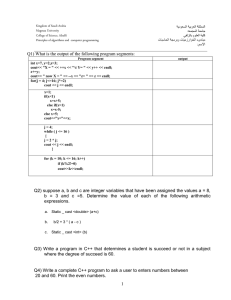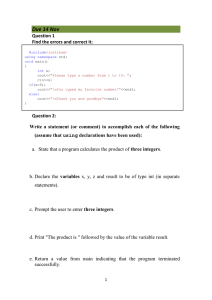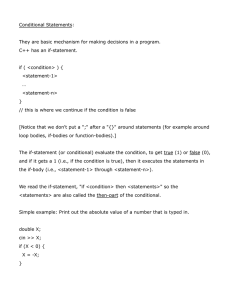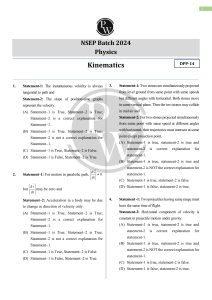C++ If Statement: Examples & Practice Problems
advertisement
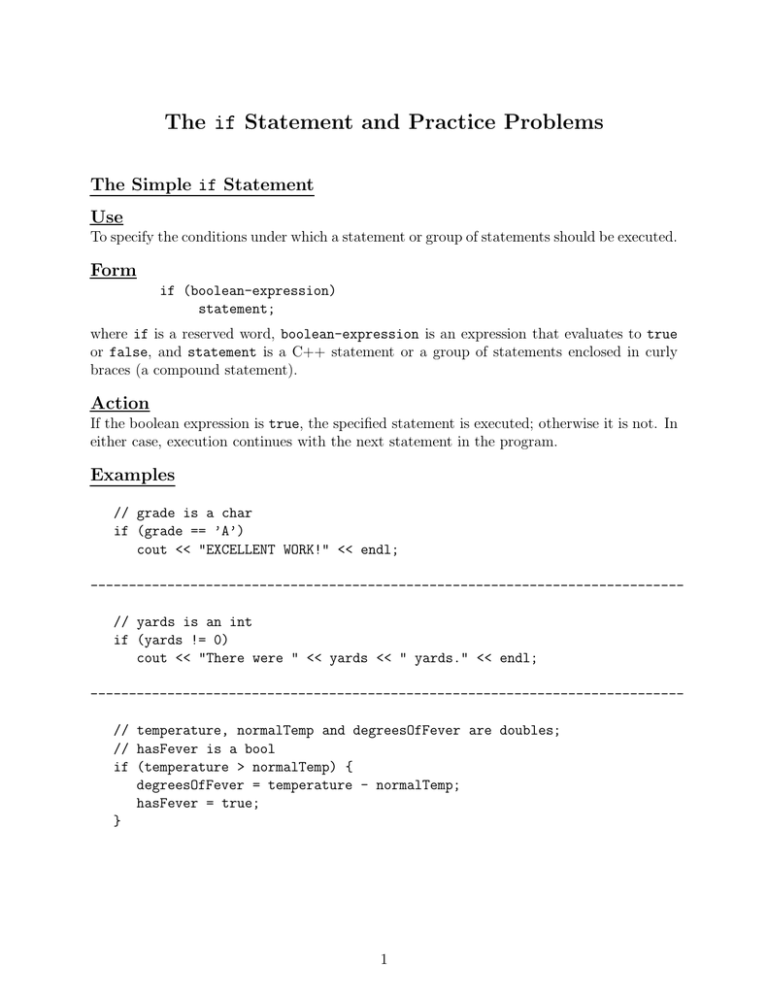
The if Statement and Practice Problems
The Simple if Statement
Use
To specify the conditions under which a statement or group of statements should be executed.
Form
if (boolean-expression)
statement;
where if is a reserved word, boolean-expression is an expression that evaluates to true
or false, and statement is a C++ statement or a group of statements enclosed in curly
braces (a compound statement).
Action
If the boolean expression is true, the specified statement is executed; otherwise it is not. In
either case, execution continues with the next statement in the program.
Examples
// grade is a char
if (grade == ’A’)
cout << "EXCELLENT WORK!" << endl;
----------------------------------------------------------------------------// yards is an int
if (yards != 0)
cout << "There were " << yards << " yards." << endl;
----------------------------------------------------------------------------// temperature, normalTemp and degreesOfFever are doubles;
// hasFever is a bool
if (temperature > normalTemp) {
degreesOfFever = temperature - normalTemp;
hasFever = true;
}
1
The if-else Statement
Use
To choose exactly one out of two statements (possibly compound statements) to be executed;
specifies the conditions under which the first statement is to be executed and provides an
alternative statement to execute if these conditions are not met.
Form
if (boolean-expression)
statement-1;
else
statement-2;
where if and else are reserved words, boolean-expression is an expression that evaluates to true or false, and statement-1 and statement-2 are C++ statements (possibly
compound statements, i.e. a group of statements enclosed by curly braces).
Action
If the boolean expression is true, statement-1 is executed and statement-2 is skipped;
otherwise statement-1 is skipped and statement-2 is executed. In either case, execution
continues with the next statement in the program.
Examples
// numItems is an int; averageCost and totalCost are doubles
if (numItems >= 0)
averageCost = totalCost / numItems;
else
cout << "No items were purchased." << endl;
--------------------------------------------------------------------const double POLLUTION_CUTOFF = 3.5;
// pollutionIndexis a double
if (pollutionIndex < POLLUTION_CUTOFF)
cout << "Safe Condition" << endl;
else
cout << "Hazardous Condition" << endl;
2
The Extended-if Statement
Use
To choose one statement (possibly compound) to be executed from among a group of statements (possibly compound); specifies the conditions under which each statement may be
executed and may contain a default statement (in an else clause at the end) to be executed
if none of these conditions are met. Note that in the absence of a final else clause, it may
be the case that none of the statements are executed.
Form
if (boolean-expression-1)
statement-1;
else if (boolean-expression-2)
statement-2;
.
.
.
else if (boolean-expression-n)
statement-n;
else
statement-default;
where if and else are reserved words, boolean-expression-1, boolean-expression-2,
. . ., boolean-expression-n are expressions that evaluate to true or false, and statement-1,
statement-2, . . ., statement-n, and statement-default are C++ statements, possibly
compound statements. (A compound statement is a group of statements enclosed by curly
braces.)
Action
The boolean expressions are evaluated in the order of their appearance to determine the
first expression that is true. The associated statement is executed, and execution continues
with the first statement following the entire if-else-if construct. If none of the boolean
expressions is true, the statement associated with the else clause is executed, and execution
then continues with the statement following the construct. If none of the boolean expressions
is true and the else clause is omitted, execution “falls through” to (continues with) the
next statement in the program after the construct.
Examples
(next page)
3
Examples
// score is a double; grade is a char
if (score == 100) {
grade = ’A’;
cout << "Superb" << endl;
}
else if (score >= 90) {
grade = ’A’;
cout << "Excellent" << endl;
}
else if (score >= 80) {
grade = ’B’;
cout << "Very Good" << endl;
}
else if (score >= 70) {
grade = ’C’;
cout << "Good" << endl;
}
else if (score >= 60)
grade = ’D’;
else
grade = ’F’;
--------------------------------------------------------------// Ch is a char
if ((Ch >= ’a’) && (Ch <= ’z’)) {
// code to process lower-case leter
}
else if ((Ch >= ’A’) && (Ch <= ’Z’)) {
// code to process upper-case leter
}
else if ((Ch >= ’0’) && (Ch <= ’9’)) {
// code to process digit character
}
else {
// code to process non-letter/non-digit characters
}
4
Practice Problems
• What is wrong with the following if statement (there are at least 3 errors). The
indentation indicates the desired behavior.
if numNeighbors >= 3 || numNeighbors = 4
++numNeighbors;
cout << "You are dead!" << endl;
else
--numNeighbors;
• Describe the output produced by this poorly indented program segment:
int number = 4;
double alpha = -1.0;
if (number > 0)
if (alpha > 0)
cout << "Here I am!" << endl;
else
cout << "No, I’m here!" << endl;
cout << "No, actually, I’m here!" << endl;
• Consider the following if statement, where doesSignificantWork, makesBreakthrough,
and nobelPrizeCandidate are all boolean variables:
if (doesSignificantWork) {
if (makesBreakthrough)
nobelPrizeCandidate = true;
else
nobelPrizeCandidate = false;
}
else if (!doesSignificantWork)
nobelPrizeCandidate = false;
First, write a simpler if statement that is equivalent to this one. Then write a single
assignment statement that does the same thing.
• Write if statements to do the following:
– If character variable taxCode is ’T’, increase price by adding the taxRate percentage of price to it.
– If integer variable opCode has the value 1, read in double values for X and Y and
calculate and print their sum.
5
– If integer variable currentNumber is odd, change its value so that it is now 3
times currentNumber plus 1, otherwise change its value so that it is now half of
currentNumber (rounded down when currentNumber is odd).
– Assign true to the boolean variable leapYear if the integer variable year is a
leap year. (A leap year is a multiple of 4, and if it is a multiple of 100, it must
also be a multiple of 400.)
– Assign a value to double variable cost depending on the value of integer variable
distance as follows:
Distance
----------------------------------0 through 100
More than 100 but not more than 500
More than 500 but less than 1,000
1,000 or more
6
Cost
---------5.00
8.00
10.00
12.00
